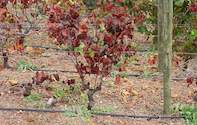Crown gall is the most common bacterial grapevine disease and occurs commonly in vines along the Olifants River and Lower Orange River area. The symptoms of crown gall include the appearance of galls on the trunk near the soil surface.

Yellow-gray galls and cracks appear in the bark generally near the graft unions. Later on the galls turn brown. Crown gall is distributed by water and farm implements. It is controlled by using registered plant material that has received hot water treatment. The galls can also be broken off after which the wounds should be treated with copper.
Viral diseases can be found in any wine-growing region and the occurrence depends on the virus status of the plant material. Plant material can be made virus-free by heat treatment. The chemical control of viruses is not possible, but it is necessary to control grapevine mealybug as it spreads the disease in a grapevine block.
Grapevine Leafroll Disease
Grapevine leafroll disease is widely used in the red cultivars Cabernet, Merlot and Chardonnay, but white varieties Cape Riesling and Semillon are also prone to leafroll. Almost no symptoms are seen during spring, but from November, leaves of red cultivars can become reddish and begin to curl downwards. However, the veins remain green.
In white cultivars the symptoms are less visible but the leaves also curl downwards. It is important to control ants and grapevine mealy bugs because they contribute to the spreading of the grapevine leafroll virus. A buffer zone between contaminated and uninfected vineyards is recommended and the tools and implements should be disinfected and cleaned when moving between the vineyards.
Shiraz Disease
Shiraz disease occurs in Merlot, Shiraz, Malbec and Gamay and is caused by ‘grapevine virus A’. The disease has also been noted in Viognier. It can be recognized as rubbery, droopy canes that do not ripen evenly as the bud break of the infected cane is delayed. Grape bunches are smaller than normal or totally absent.
The leaves and veins are coloured purple and the leaves also fall off very late. There is no treatment for this disease and the vines usually die within three to five years.
It spreads naturally through the vineyard, but the grapevine mealybug is also a factor in the spreading of Shiraz disease. Studies have determined that the disease can be eliminated by heat treatment of the original plant material. Infected vines are removed and burned.
Other Vine Diseases
There are many other diseases and one that has just been discovered in vines is Aster Yellows disease. Chardonnay especially is very sensitive to this disease. Symptoms of ‘Aster Yellows’ include wrinkled leaves early in the season. The leaves of white cultivars turn yellow and red cultivars’ leaves become reddish.
The leaves are thicker than normal, brittle and curled downwards. The shoots have shorter internodes and impaired growth. This is a very serious disease and luckily, it only occurs in a few areas, so it’s very important to report any strange symptoms in the vineyards to VinPro.
Preliminary studies indicate that Aster Yellows may be transmitted by a leafhopper. Infected leaves should be removed and after the season the whole vine should be removed with roots and all.
By Marinda Louw